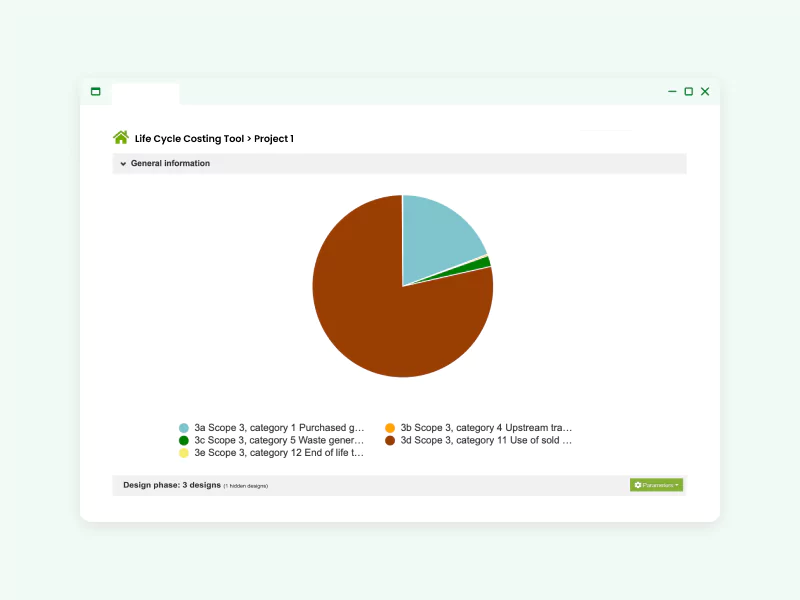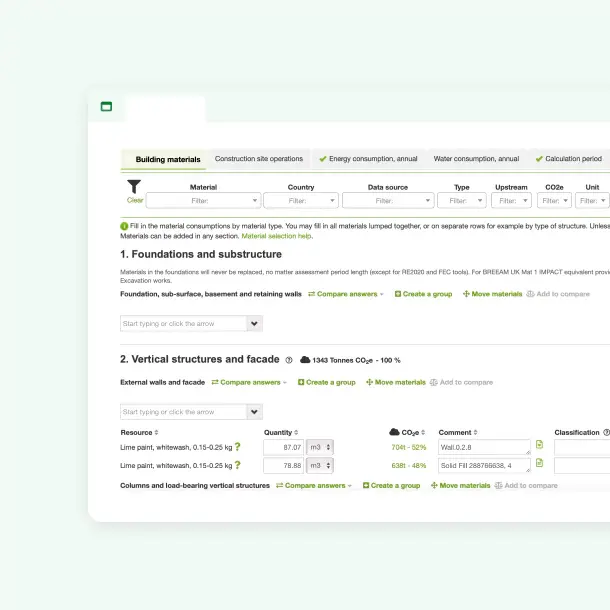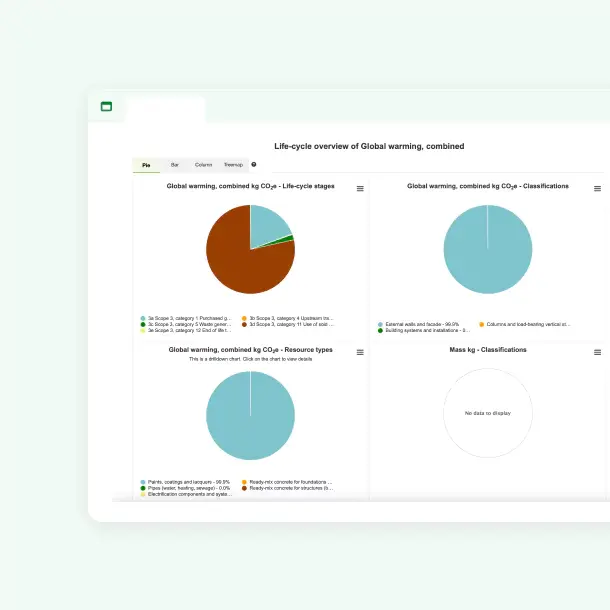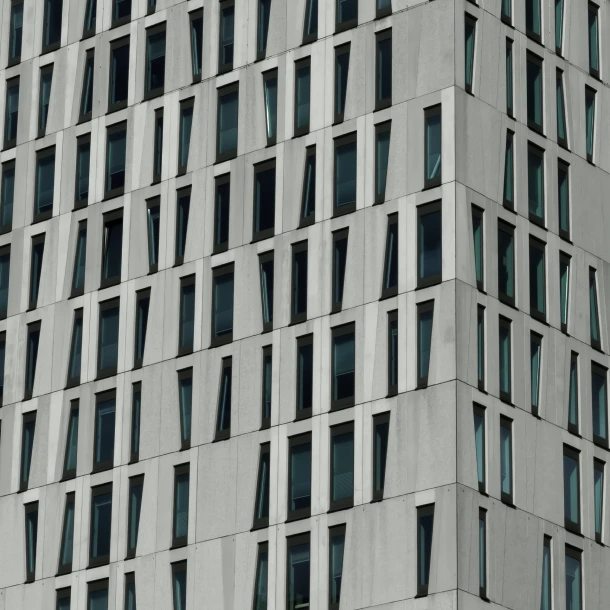Carbon strategy tool
Convert LCA results to GHG data
Reliably translate your construction project LCA results into GHG data for reporting.

Benefits
Streamline LCA to GHG data conversion
As organizational greenhouse gas (GHG) or carbon reporting becomes mandatory for more medium to large companies, a common concern is how to source accurate data from suppliers.
For companies involved in real estate and construction, high-quality data is likely to be available in the form of project life-cycle assessments (LCAs). However, until now, it has been challenging to translate project-specific LCA data to GHG Protocol scopes and categories.
One Click LCA’s Carbon Strategy Tool solves this problem by reliably translating LCA project data into GHG reporting in line with the GHG Protocol.

Capabilities
Generate GHG reports from LCA data
Use your existing project LCA data
Project LCA data is the highest quality GHG data available. Import your LCA results into the tool for accurate GHG reporting.
Select the activities you control
Tick off all the project activities that are owned or controlled by your organization and which are controlled by a third party, for example a supplier.
Get GHG reporting-ready results
Generate results in a format that meets the requirements of the GHG Protocol reporting.

Who is it for?
The Carbon Strategy Tool can be used by architects, engineers, and construction companies for sharing LCA data that their real estate, investor, or developer clients can use in their carbon reporting.
Real estate investors, owners, developers
Request project LCA results or provide project teams with One Click LCA Building LCA software. Import the LCA results into your GHG Reporting.
Architects, designers, engineers and consultants
Collate all project LCA data to support your investor or developer clients’ GHG reporting. If project data is missing you can use One Click LCA’s generic project profiles.
Construction firms
Collate all project LCA for your GHG reporting. For construction firms who own the on-site machinery, site fuel emissions will be grouped under Scope 1 direct emissions.



Differences between LCA results and GHG reporting
Who controls the activity that causes the emissions
The GHG Protocol groups emissions into three scopes according to who controls the activity: the reporting company or a separate organization. By contrast, an LCA is not concerned with who controls an activity, just the fact that it happens.
The GHG Protocol scopes are:
- Scope 1: direct emissions released as a result of company activities.
- Scope 2: indirect emissions from purchased energy.
- Scope 3: all other indirect emissions, that are not included in scope 2.
When emissions are reported
An LCA looks at the entire life-cycle of a product or service. whereas the GHG Protocol reports emissions based on the period in which they arose. This is often a calendar year or a quarter.
Where future emissions are locked-in to sold products, they are accounted for in Scope 3 emissions in specific categories.
Construction LCA results are grouped into life-cycle stages ranging from A to D, covering life-cycle phases from construction to use phase to end of life and impacts beyond the system boundary.
Which emissions are reported
The standard emission factors basis of the GHG Protocol differs from construction LCAs.
GHG Protocol Scopes 1 and 2 only cover direct combustion emissions from the seven Kyoto protocol gases: carbon dioxide (CO2), methane (CH4), nitrous oxide (N2O), hydrofluorocarbons (HFCs), perfluorocarbons (PCFs), sulphur hexafluoride (SF6) and nitrogen trifluoride (NF3).
Construction LCAs, however, always use life-cycle based emission factors and consider all greenhouse gases.
.webp)


Carbon strategy tool
Get the One Click LCA GHG reporting suite
The One Click LCA Carbon Strategy Tool is a project-level tool that links project-specific LCA data to GHG reporting requirements. Architects, engineers and construction companies can use the tool to share project data that their real estate, investor, or developer clients can use in their Scope 1-3 GHG reporting.

Get emission results that comply with
Frequently asked questions
How do I get access to the Carbon Strategy Tool?
The One Click LCA Carbon Strategy Tool is available as part of the One Click LCA Carbon Strategy Pack. This pack also includes a range of tools to help deliver climate strategy goals, including Carbon Designer, Net Zero Tool, building circularity and life-cycle costing, as well as tailored onboarding.
It is compatible with all One Click LCA Building LCA tools. However, there is only limited compatibility with the RE2020 and Energie Carbone tools. When using these tools, it is only building materials that are directly transposed to GHG Protocol reporting.
Why do I need to use LCA data for GHG reporting?
Project-specific life-cycle assessment (LCA) data is the most accurate greenhouse gas (GHG) data available. Using this data in GHG reporting enables companies to demonstrate improvements and report meaningful figures towards corporate climate strategy objectives and to comply with GHG reporting initiatives including the GHG Protocol and GRESB.
Choose this option if:
- You want to have transparent, clear, and fixed low prices for the entire delivery process of EPDs.
- You want to offer your own supply chain an affordable and easy to use solution to deliver product EPDs for your projects.
- You have limited or no experience with EPD process and want to have an experienced LCA professional review your data.
- You want to have an experienced LCA professional review your work before it is submitted to the third-party verifier.
- You want to have a single point of contact and responsibility for compliance of the results and deadlines.
- You are able gather, input, and document the product manufacturing data and product information for your products.
What emission sources can be reported?
- You can report emission sources according to ISO 14069, the GHG Protocol, and CDP standard categories. These include:
- Scope 1: Direct emissions from stationary and mobile combustion sources, fugitive emissions, processes and biomass emissions
- Scope 2: Indirect emissions from electricity, heating and cooling consumption
- Scope 3: Purchased goods and services, capital goods, waste, business travel and commuting, investments, freight, use and end-of-life of sold products, downstream leasing and franchises.
What emissions data is included?
One Click LCA integrates emissions factors for energy (IEA, local energy agencies and providers, and One Click LCA’s own datasets), goods and services (DEFRA, WWF, Base Carbone), extended capital goods from the Carbon Heroes Benchmark Program, and additional datasets.
You can also add your private emission factor data or ask us to add compliant data for your sector if anything is missing.
Not all data sources break down data based on gasses, and in such cases, the assessment considers all greenhouse gasses. The assessment considers at a minimum all Kyoto Protocol gasses (CO2, CH4, N2O, HFCs, PFCs, SF6 and NF3) on a 100-year timeframe.
How does GHG reporting differ from life-cycle assessment?
The GHG Protocol groups emissions into different scopes according to who directly controls the emissions-releasing activity – the reporting company or another organization. By contrast, an LCA is not concerned with who controls an activity, just that it happens.
The standard emission factors basis is different: The GHG Protocol scopes 1 and 2 only take into account direct (combustion) emissions, whereas LCAs always use life-cycle based emission factors and consider all green house gasses.
The GHG Protocol reports emissions based on the period in which they arose, often a calendar year or a quarter. Where future emissions are locked-in by sold products, they are accounted for in Scope 3 emissions in specific categories. An LCA looks at the entire life-cycle of a product or service: from first manufacture to end-of-life, as well as impacts beyond the system boundary. LCA results are grouped into life-cycle modules A to D.
Is the tool compatible with the One Click LCA building LCA tool?
Yes, the tool is compatible with any standards-aligned One Click LCA building LCA tool and is available as part of the One Click LCA Carbon Strategy Pack. It does not apply future emissions discounting and it separates biogenic carbon emissions. The tool currently has limited compatibility with our RE2020 and Énergie Carbone tools. Only building materials are directly transposed to GHG Protocol reporting when using these tools.
Is this suitable for consultants?
Yes. Consultants can work on as many client assignments as needed.
Where can I publish EPDs created with One Click LCA EPD Generator?
You can publish EPDs created with One Click LCA in virtually any EPD program.
One Click LCA is pre-verified for the International EPD System, EPD Hub, and EPD Australasia. This means the process is straightforward and documentation is aligned. One Click LCA is also approved by the Concrete Sustainability Council for achieving its sustainable concrete ratings.
One Click LCA is also used to publish FDES for the French INIES EPD program, with pre-generated INIES documentation. One Click LCA is also used to publish EPDs in IBU, EPD Norge, UL and PEP Ecopassport EPD programs.
We publish EPDs with EPD International (Environdec). Environdec has a mutual recognition with other established Program Operators, including: AENOR GlobalEPD (Spain); IBU (Germany); EPD Norge (Norway) and SCS Global Services (USA).
With our Expert plan, we can also support program-specific extensions for other Program Operators, including: INIES, Nationale Milieudatabaase, EPD Norge, and UL Environment. However, please note that the pre-verified solution is not available when publishing to these platforms.
What data does One Click LCA cover?
The Pre-verified EPD Generator gives you access to One Click LCA’s extensive EPD database and up to 150 relevant Ecoinvent datasets, with the option to upgrade to access the entire Ecoinvent database. Want to learn about other options? Please write to us at sales@oneclicklca.com or book a demo from this page.
Learn more
Join free LCA trainings
Join the 30,000+ professionals who've grown their careers by getting certified with One Click LCA Academy.
Listen to free LCA webinars
Save your seat for an upcoming webinar or training course.
Read news and articles
Get insights from LCA experts and learn more about life-cycle assessments and One Click LCA software.

Generate GHG reporting data
Talk to our experts and see the Carbon Strategy Tool in action.